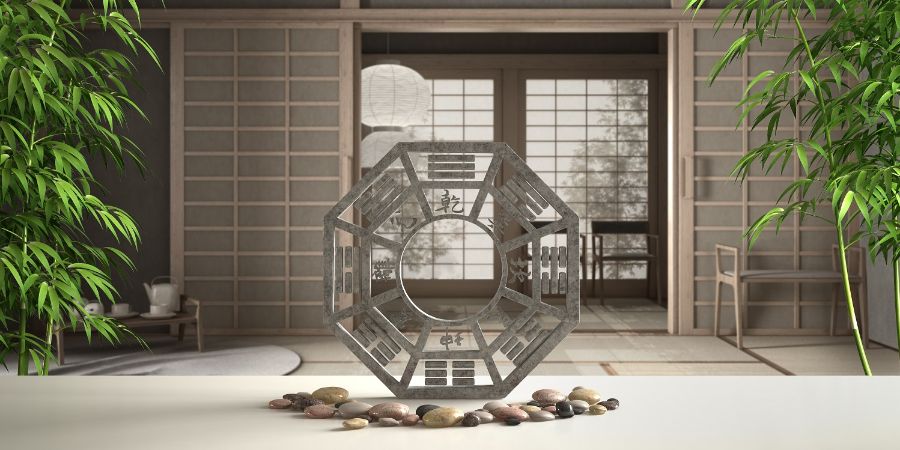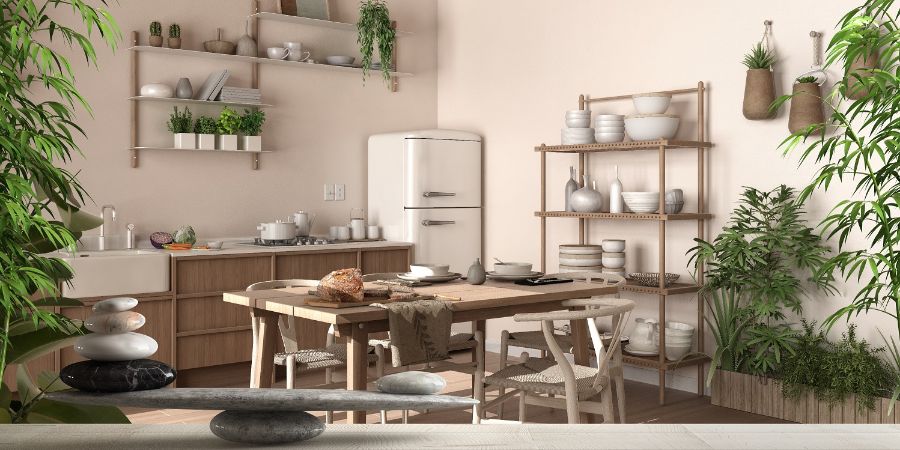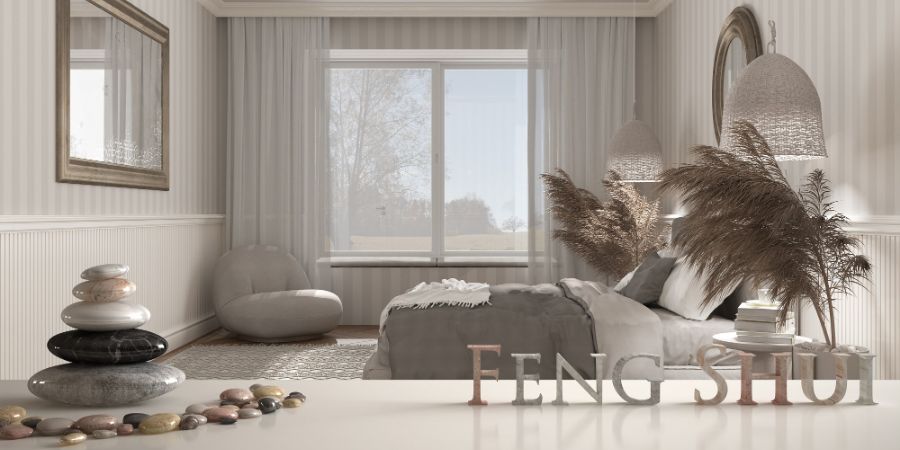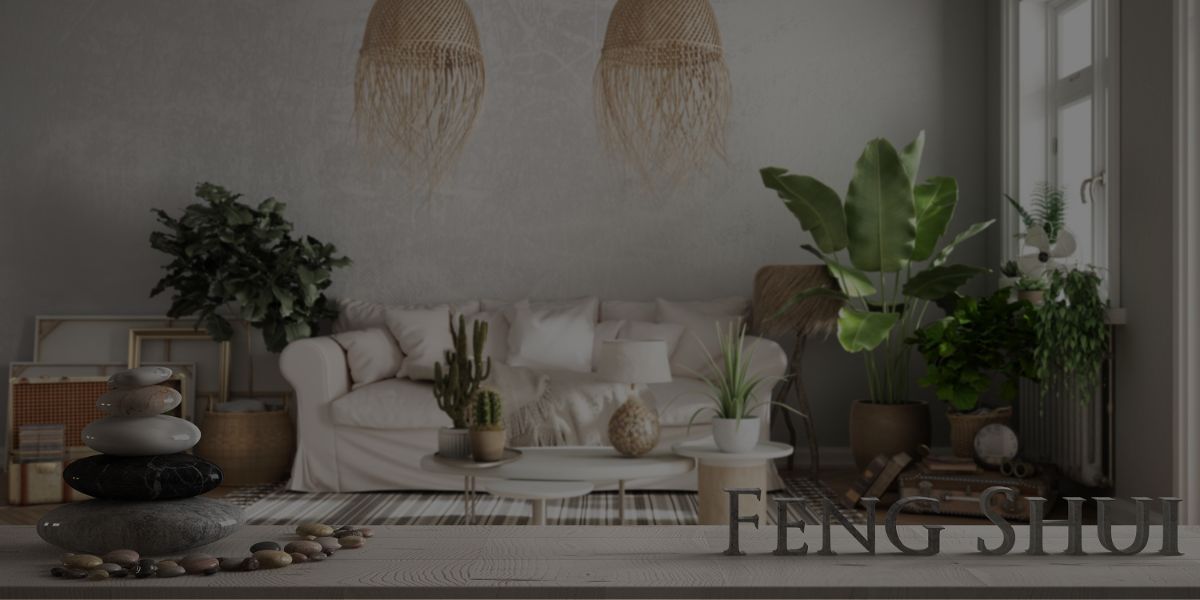What is Feng Shui design? If you’ve ever wondered what Feng Shui is and how it can be applied to your home, you’re in luck! Consider this your beginner’s guide to Feng Shui design!
We’ll not only delve into what Feng Shui is – we’ll also discuss the basic principles of the practice AND show you how you can apply these principles to your own home.
So, whether you’re just curious about Feng Shui or are looking for ways to improve your current home decor, read on for everything you need to know!
What Is Feng Shui and What Is Its Purpose?
Feng Shui – translated to mean “wind-water” – is an ancient Chinese practice that’s been around for over 4000 years. In a nutshell, it’s all about creating balance and harmony in one’s environment. Moreover, it’s based on the belief that our surroundings have a direct impact on our mood, health, and overall wellbeing.
Feng Shui practitioners believe that by making small changes to our surroundings, we can make big changes in our lives. Although Feng Shui is often used in interior design/decorating, it can also be applied to architecture, landscape design, and even personal fashion choices!
What Are The 5 Elements Of Feng Shui Design?
In order to create balance and harmony in your home using Feng Shui principles, you’ll need to become familiar with the five Feng Shui elements:
- Wood
- Fire
- Earth
- Metal
- Water
Each of these Feng Shui elements represents a different aspect of our lives, and when used correctly, can help to enhance that area. Wood represents growth, fire represents enthusiasm and passion, earth represents stability and balance, metal represents focus and clarity, and water represents refreshment and purification.
Breaking Down The 5 Elements
Each of the 5 elements in Feng Shui design has its own associated:
- Qualities
- Shape(s)
- Color(s)
- Season
- Area(s) of the home it works best in
Wood
- Qualities: Growth, expansion, new beginnings, and fertility
- Shape: Rectangle
- Colors: Green and brown
- Season: Spring
- Works best east and southeast areas of the home
Fire
- Qualities: Enthusiasm, passion, and transformation
- Shape: Triangle
- Colors: Red, orange, and purple
- Season: Summer
- Works best in the south area of the home
Earth
- Qualities: Stability, balance, and support
- Shapes: Square and rectangle
- Colors: Yellow, brown, and beige
- Season: Late summer
- Works best in the southwest and northeast areas of the home
Metal
- Qualities: Clarity, focus, and precision
- Shape: Circle
- Colors: White, gray, and black
- Season: Autumn
- Works best in the west and northwest areas of the home
Water
- Qualities: Refreshment, purification, and Feng Shui wealth
- Shape: Wavy lines
- Colors: Blue and black
- Season: Winter
- Works best in the north area of the home
What Are The Basic Principles Of Feng Shui Design?
There are many Feng Shui principles, and if we tried to list them all, we’d be here all day! So, with that in mind, let’s take at look at 3 of the most important ones…

1. Bagua
The first principle is called “Feng Shui Bagua.” This refers to the Feng Shui energy map, which is divided into 9 sections (each of which represents a different area of your life). The 9 sections of the Bagua map are:
- Wealth and Prosperity
- Fame and Reputation
- Love and Relationships
- Health and Family
- Creativity and Children
- Helpful People and Travel
- Career
- Knowledge and Self-Cultivation
- Family Heritage
In order to Feng Shui your home correctly, you’ll need to identify which areas of your life need the most improvement and focus on those areas specifically.
PRO TIP: Learn how to use the Bagua map correctly in this informative 2-part blog series!
2. Colors
As we briefly mentioned before, each of the Feng Shui elements is represented by a specific color. And, according to Feng Shui principles, certain colors can have a positive or negative effect on our mood and wellbeing. For example, if you’re hoping to increase your wealth and prosperity (represented by the Feng Shui element of wood), you might want to use green or brown colors in your home decor.
On the other hand, if you’re hoping to enhance your love and relationships (represented by the Feng Shui element of fire), you might want to use red or pink. Feng Shui designers believe that by using these specific colors in our homes, we can encourage the positive energy of that Feng Shui element to flow more freely.
Not sure what colors to use in your home? Check out this helpful color guide!
3. Chi
Last but not least, we can’t touch on Feng Shui design principles without talking about chi (or “qi”). Most simply put, this refers to the flow of energy in our homes and how it can impact our lives.
According to experts in this field, Chi should be able to flow freely throughout our homes in order to encourage good luck, health, and fortune. However, there are a number of things that can block the flow of chi, such as:
- Clutter
- Poor Feng Shui design
- Poor/incorrect color choices
- Bad placement of furniture
- Unhealthy plants
Feng Shui practitioners believe that by unblocking chi and allowing it to flow freely throughout our homes, we can improve our mental and physical wellbeing. So, if you’re hoping to improve the chi flow in your home, be sure to declutter regularly and pay attention to your Feng Shui design!
Yin and Yang Energy
We can’t discuss chi without also discussing Yin and Yang energy, too. Yin energy is more passive, while Yang energy is more active. Feng Shui practitioners believe that a healthy balance of Yin and Yang energy in our homes is essential for a happy and harmonious life.
Too much Yin energy can result in feelings of lethargy, while too much Yang energy can result in feelings of anxiety.
So, how do we achieve a healthy balance of Yin and Yang energy in our homes? Feng Shui designers believe that by using the Feng Shui elements (wood, fire, earth, metal, and water), we can encourage the flow of chi and achieve harmony in our lives.
How To Use Feng Shui in Interior Design: Room By Room
Now that we’ve answered the question, “What is Feng Shui design?” and gone over some of the basics, let’s take a more in-depth look at how to Feng Shui your home, room by room…
Feng Shui Bedroom Design
The bedroom is one of the most important rooms in the house when it comes to Feng Shui design. After all, this is the room where we spend a third of our lives!
There are a few Feng Shui bedroom tips that you can follow in order to create a more restful and relaxing space, such as:
- Placing your bed in the “commanding position” (i.e. away from the door and not in line with it)
- Making sure your headboard is solid (this means no storage space behind it!)
- Opting for light and airy colors, like white, blue, or green
- Adding Feng Shui symbols of love and relationships, such as hearts or pink lotus flowers
- Avoiding Feng Shui symbols of death, such as skulls or black cats
For more Feng Shui bedroom design tips, be sure to check out this blog post by Dreams!
Feng Shui Kitchen Design
The kitchen is another important room to consider when Feng Shui-ing your home. After all, this is where we prepare our food – which, of course, nourishes our bodies. As such, it’s vital that the energy in this space is positive.
Some Feng Shui kitchen design tips that you might want to follow include:
- Placing the stove in the “commanding position” (i.e. away from the door and not in line with it)
- Making sure the fridge is not in line with the stove
- Adding Feng Shui symbols of wealth and prosperity, such as coins or a bamboo plant
- Avoiding Feng Shui symbols of bad luck, such as knives or sharp objects
For more Feng Shui kitchen design tips, be sure to check out these 9 tips, courtesy of The Spruce!

Feng Shui Living Room Design
The living room is another important space to consider when Feng Shui-ing your home. After all, this is typically where we entertain guests and spend time with our loved ones. For this reason, it’s important that the energy in this space is both positive and inviting.
Some Feng Shui living room design tips that you might want to follow include:
- Placing the sofa in the “commanding position” (i.e. away from the door and not in line with it)
- Making sure there is a clear path from the door to the sofa
- Adding Feng Shui symbols of good luck, such as a lucky bamboo plant or a Feng Shui money frog
- Avoiding Feng Shui symbols of bad luck, such as a clock or sharp objects
For more Feng Shui living room design tips, be sure to check out My Domaine’s Top 10 Tips!
Feng Shui Bathroom Design
Lastly, when considering space inside of the home, we can’t forget about the bathroom! Although it’s often overlooked, the bathroom is actually a very important space to consider when Feng Shui-ing your home. That’s because this is where we cleanse our bodies and release negativity.
Thus, it’s important that the energy in this space is positive and rejuvenating.
Some Feng Shui bathroom design tips that you might want to follow include:
- Placing the toilet in the “commanding position” (i.e. away from the door and not in line with it)
- Making sure there is a clear path from the door to the toilet
- Adding Feng Shui symbols of good luck, such as a Feng Shui money frog or a lucky bamboo plant
- Avoiding Feng Shui symbols of bad luck, such as a black cat or a sharp object
For more Feng Shui bathroom design tips, be sure to check out this article by Noken!
The Importance Of Feng Shui in Landscape Design
It’s easy to forget that the outside of your home is just as important as the inside. In fact, Feng Shui is just as influential over landscape design as it is interior design/decorating! After all, this is the area of our home that’s closest to nature. As such, it’s important to make sure that the energy in this space is positive, grounding, and nourishing.
So, when approaching your landscape design, keep the following in mind:
- Choose Feng Shui-friendly plants, such as bamboo or cherry blossoms
- Add Feng Shui symbols of good luck, such as a Feng Shui money frog or a lucky bamboo plant
- Avoid Feng Shui symbols of bad luck, such as a black cat or a sharp object
- If you have a garden, plant Feng Shui-friendly vegetables, such as tomatoes or cucumbers
Applying The Bagua Map Outdoors
As we mentioned earlier, the Bagua Map is used to help define areas of your home and analyze the flow of energy within each space. This is done by dividing your home into the 9 sections discussed before, which each correspond to a different area of your life.
So, how should you be applying the Bagua map to the exterior of your home?
Well, you can start by taking a look at the Feng Shui Bagua Map and determining which area of your life you’d like to focus on. From there, you can begin to make changes to your landscape design that will promote positive energy flow in that area.
For example, if you’re looking to improve your love life, you might want to consider adding a Feng Shui-friendly plant, such as bamboo or cherry blossoms, to your yard.
On the other hand, if you’re looking to improve your career prospects, you might want to add a Feng Shui money frog to your landscape design.
As always, be sure to avoid Feng Shui symbols of bad luck, such as a black cat or a sharp object.
DID YOU KNOW that QC Design School offers self-paced, online certification courses in Interior Decorating, Landscape Design, and more? Check out our full course list for more info!
Do’s and Don’ts in Feng Shui Design
Now that we’ve gone over some of the basics, let’s take a look at some Feng Shui design do’s and don’ts…
Do:
- Make sure your home is well-lit (as this will help to create a positive energy flow throughout your space)!
- Add Feng Shui symbols of good luck, such as a lucky bamboo plant or a Feng Shui money frog!
- Have some sort of flowing water element in your home (as this is said to bring good luck and prosperity)!
- Avoid Feng Shui symbols of bad luck, such as a black cat or a sharp object!
- Place your bed, desk, stove, and couch in a “commanding position”!
- Give your home’s entryway special attention!
- Create balance in your home by incorporating the Feng Shui element of each space!
- Embrace negative space (without having too much of it, obviously)!
- Choose your room colors wisely!
- Incorporate nature and greenery throughout your home!
- Regularly go through each room and declutter anything you don’t need or use!
Don’t:
- Forget to Feng Shui your outdoor spaces!
- Neglect the importance of balance in Feng Shui design!
- Use too many Feng Shui symbols (as this can create a sense of chaos)!
- Choose room colors that are too harsh or bright (as this can be overwhelming)!
- Let your houseplants die (as this can create negative energy)!
- Ignore the Feng Shui of your home’s entryway!
- Block doors!
- Clutter up your space!
- Leave out broken objects!
- Let your windows get too dusty/dirty!
- Use the Bagua map incorrectly throughout each room!
- Create clutter under your bed by storing things down there!
- Hang artwork or wall decor too low (which can bring down chi)!
- Place your bed directly in front of a window (as this can block your good luck)!

Want To Become a Feng Shui Designer?
Perhaps you’ve read this far and are now thinking, “I want to become a Feng Shui designer!”
If so, then you’re in luck! Here at QC Design School, we offer a self-paced, online Feng Shui Design Course that’ll teach you everything you need to know about this ancient practice.
QC Design School’s Feng Shui Course
Below is an overview of what you’ll learn in each unit:
Unit A
- The basic principles of Feng Shui design (including chi, Yin and Yang energy, the 5 elements and the Celestial Animals)
- What a Feng Shui Consultant is and what they do
- The most fundamental Feng Shui concepts
- Misconceptions about Feng Shui design
- Types of clients you’ll work with throughout your career
Unit B
- Reading energy in a home
- Properly interpreting the Bagua map
- Applying the Bagua map correctly to a floorplan
- Drawing rough sketches and professionally-scaled floorplans
- The 8 Trigrams (or “Guas“)
- Layering the Bagua map
Unit C
- Cures and symbols for correcting energy imbalances/attracting positive chi
- Traditional Feng Shui solutions for restoring balance (e.g. space cleansing ceremonies)
- Decluttering for Feng Shui design
- Learn common Feng Shui symbols via the symbol index
Unit D
- How to combine Feng Shui design with interior decorating principles
- Creating aesthetically pleasing color schemes
- Choosing the right lighting options and decorative accessories
- Color theory and associations
- Traditional Feng Shui colors
Unit E
- How to apply what you’ve learned to a variety of spaces
- The positive impacts of Feng Shui in both public and private spaces
- Balancing energy in an office space
- Applying Feng Shui principles outdoors
- Applying Feng Shui principles to specific rooms within a home (i.e. bedrooms, kitchens, living rooms, bathrooms, garages, and more)
Unit F
- Starting your very own Feng Shui design consulting business
- How to write a business plan from scratch
- Marketing and selling your business/services
- Finding and working with clients successfully
- Conducting client consultations
- Handling your business’s finances
- And more!
Learn more about how YOU can become an Advanced Feng Shui Design Professional (AFDP) in as little as 12 short weeks with QC’s self-paced, online Feng Shui Design Course!
Wrapping It Up
We hope this article has provided you with a helpful introduction to Feng Shui design principles and that you now have a better understanding of what Feng Shui is (and what it isn’t)!
If you’re interested in learning more about Feng Shui or becoming a Feng Shui designer, then we invite you to check out QC Design School’s Feng Shui Design Course. And, as always, if you have any questions or comments, don’t hesitate to drop them down below.
Thanks for reading… And good luck on your Feng Shui design journey!


